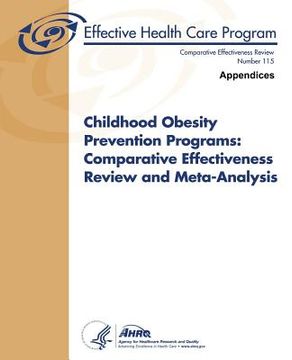Childhood Obesity Prevention Programs: Comparative Effectiveness Review and Meta-Analysis (Appendices): Comparative Effectiveness Review Number 115 (in English)
Synopsis "Childhood Obesity Prevention Programs: Comparative Effectiveness Review and Meta-Analysis (Appendices): Comparative Effectiveness Review Number 115 (in English)"
"Childhood Obesity Prevention Programs: Comparative Effectiveness Review and Meta-Analysis" - Appendices (see also "Main Report") - The epidemic of childhood obesity is threatening America's children. Overweight children and adolescents are at greater risk for health problems compared with their normal-weight counterparts and are more likely to become obese adults. Obese children and adolescents are more likely to have serious health conditions, such as cardiovascular, metabolic, and psychosocial illnesses; type 2 diabetes; hypertension; high cholesterol; stroke; heart disease; nonalcoholic fatty liver disease; certain cancers; and arthritis. Other reported health consequences of childhood obesity include eating disorders and mental health issues, such as depression and low self-esteem. Childhood obesity is highly prevalent in the U.S. Obesity is the result of biological, behavioral, social, environmental, and economic factors and the complex interactions among these factors that promote a positive energy balance. At present, the way that these factors contribute to the disparities in obesity prevalence among population groups in the U.S. is poorly understood. Nevertheless, a growing body of research suggests that many factors interact, including individual factors, home influences, the school environment, factors in the local community, and policies implemented at the regional and national level. They can contribute to obesogenic environments and affect children's weight. A number of leading health organizations and expert panels, including the World Health Organization and an Institute of Medicine expert panel, have recommended comprehensive interventions to fight the growing obesity epidemic. For this review, we differentiate between prevention, often called "intervention" in the childhood obesity research field, and treatment, also called "weight management" or "weight loss." The main goal of most childhood obesity prevention programs is to prevent nonoverweight children from becoming overweight or obese, while the primary objective of obesity treatment programs is for pediatric patients to lose weight. Programs designed for obesity prevention may also help overweight or obese children lose or stabilize their weight. The present review focuses on prevention. The Key Questions are as follows: KQ1. What is the comparative effectiveness of school-based interventions for the prevention of obesity or overweight in children? KQ2. What is the comparative effectiveness of home-based interventions for the prevention of obesity or overweight in children? KQ3. What is the comparative effectiveness of primary care-based interventions for the prevention of obesity or overweight in children? KQ4. What is the comparative effectiveness of childcare setting-based interventions for the prevention of obesity or overweight in children? KQ5. What is the comparative effectiveness of community-based or environment-level interventions for the prevention of obesity or overweight in children? KQ6. What is the comparative effectiveness of consumer health informatics applications for the prevention of obesity or overweight in children? KQ7. What is the comparative effectiveness of multisetting interventions for the prevention of obesity or overweight in children?

